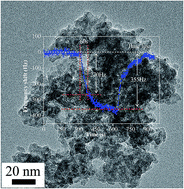A copper–manganese composite oxide as QCM sensing layers for detection of formaldehyde gas
Abstract
A copper–manganese composite oxide was synthesized by controlling the molar ratio of Cu to Mn and calcination temperature. Scanning electron microscopy, transmission electron microscopy, X-ray diffraction, and nitrogen adsorption–desorption measurements were employed to characterize the obtained products. The as-prepared copper–manganese composite oxide functionalized QCM resonators were fabricated and explored for HCHO sensing. The copper–manganese composite oxide functionalized QCM resonators had a significant response to HCHO, and the sensitivity of the resonators reached 6.35 Hz (μg ppm)−1. Neither the response nor the sensing profile observed significant changes after 60 days. The linear equation between the response of the QCM resonator and HCHO concentration endows the copper–manganese composite oxide functionalized QCM resonators with a capability of HCHO quantitative analysis. The adsorption–desorption process via hydrogen bonding between the oxygen of the copper–manganese composite oxide and HCHO molecules may be a plausible sensing mechanism for HCHO sensing.



 Please wait while we load your content...
Please wait while we load your content...